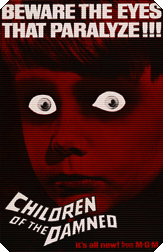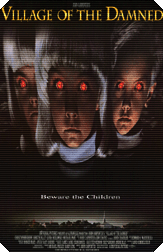Village of the Damned
Reviewed by Galen Strickland
John Wyndham's The Midwich Cuckoos has been adapted to film several times, the first version, Village of the Damned from 1960, being the most faithful. Most of the characters have the same names as the book, although a few were eliminated or combined as a composite character, likely as a way to keep the film's budget down. In the novel, Gordon Zellaby is a prominent citizen of Midwich, apparently retired from business (or academia), but who is perpetually researching and writing "The Work." George Sanders portrays him in the film, and he is a highly respected professor or scientist or philosopher (unspecified). The beautiful Barbara Shelley plays his wife Anthea, who gives birth to David, who becomes leader of the Children. In the book, David was the natural son of Gordon, not one of the Children, but since it was not explained as to why, we can assume Anthea was already pregnant at the time of the incident. Their daughter is missing from the film, and her fiance is combined with another character to become Alan Bernard (Michael Gwynn), Anthea's brother. Otherwise the characters and incidents are very close to the book.
While faithful, it also suffers from some of the same faults. First, it's very short, only 77 minutes. The Children develop in the womb faster than normal, and after birth their growth, both physical and mental, is rapid. Both the book and film span several years but they jump over huge chunks of time, not enough detail given to how or why it is happening. Zellaby discovers that the Children are connected telepathically, but we don't get to see the events that lead to that discovery. It also becomes apparent the Children can read the minds of their parents and others in the village. Zellaby is convinced the Children should be studied, while others sense the danger. It is not only that his son is one of them, but his scientific curiosity tells him they have a unique opportunity to learn from them. However, in the end he also sees them as a threat and devises a method to eliminate them. As in the book, they learn their predicament is not unique, there were other similar births in various parts of the world. Are all of the Children killed, or are there a few survivors?
 |
Wyndham never wrote a sequel, but apparently MGM British Studios was pleased with the performance of the original film, so they took it upon themselves to create their own continuation. The credits for Children of the Damned say it is a sequel to (not based on) John Wyndham's The Midwich Cuckoos, as opposed to a sequel to the 1960 film. There are several differences which indicate it was merely "suggested" by events in the book or earlier film. Instead of all the children sharing a similar appearance and having been born together, the ones in this film are singular to their area. One is from England, another from Russia, with others from India, Nigeria, China, etc. A representative from UNESCO endeavors to bring them to their respective country's embassy in London, but when the governments of those nations realize the potential of their child they attempt to get them out of England and back to their homeland as soon as possible. The Children have other ideas.
The two leads (Ian Hendry and Alan Badel) seem to have switched places with characters in the book and VotD. Alan Bernard was a military man and Gordon Zellaby the scientist. Hendry plays Col. Llewellyn, but his actions are closer to those of Zellaby's, while Badel's Dr. Neville seems to be working closely with the government and military. The English boy, Paul Looran (Clive Powell in his only film role), is the leader, but I believe he speaks in only one scene. Other times he has other people speak for him, most often it is his aunt Susan (Barbara Ferris). Paul collects the other Children and they make a place for themselves in an abandoned church, with Susan compelled to come with them and run errands for them. As with the previous versions, we don't learn the true nature of the Children, whether they are alien or a human mutation, and it seems the Children don't know themselves. All they know is they exist and they want to survive. If there is any bad guy in this story it is Colin Webster (Alfred Burke), apparently a government agent, maybe MI5. It is his actions that cause the Children to retreat to the church, and he is also responsible for several agents' deaths. Even though it is the Childrens' powers that compelled the agents to kill another or themselves, the Children were merely acting out of self-preservation, and it was Webster's orders that precipitated the incidents.
The two films end in a similar manner but there are also differences. In VotD, no one, not even Zellaby at the end, thought there was a chance that humanity could co-exist with the Children, especially if they were allowed to mature and procreate. Several characters in CotD were convinced the Children should be given a chance to make a place for themselves in the world, and their eventual fate was as much an accident as it was from malicious intent. Both films are worth watching, and re-watching from time to time. This was at least the third or fourth time for me to see VotD, and probably the third for CotD. It took me four attempts to get them from Netflix. It is a combined edition with both on one disc, and each time what Netlix sent was damaged beyond playability, in fact I suspect one of those times I was sent the same disc I had reported damaged before. So I bought it from amazon at a very reasonable price and I think I will be content to leave this one in my video library for later viewings.
 |
It is unfortunate I cannot say the same for John Carpenter's 1995 remake. This is just the second time I've seen it, and I don't think I would have bothered if not for wanting this review to be as complete a look at Wyndham's creation as possible. Carpenter has done some very good movies in the past, including remakes. I consider his The Thing to be superior to the original, not only for the advanced special effects but also because he stuck closer to the original Campbell short story. In his defense, I have recently read that he was just a hired director for this film, he did not develop the screenplay or production himself. Still, one would expect him to incorporate some of his usual touches on anything he does, but if he tried here he failed. A paranoid atmosphere similar to The Thing would have been appropriate, or an eerie score as he provided for that or Halloween or Vampires. Instead we get acting performances that appear phoned in, illogical jumps in the action, and an added character (Kirstie Alley's Dr. Verner) which adds nothing to the story but more confusion.
Hers is close to the worst performance in the film, only rivaled by Pippa Pearthree, the vicar's wife, and Mark Hamill as the vicar didn't fare much better. It had been a long time since I'd seen this, I believe on cable sometime in the late '90s, so I wasn't aware of one of the actors at that time. We know that a lot of child actors are groomed for their careers, some making it into adult roles, most not. The part of David, one of the Children, is played by Thomas Dekker, later of Heroes and The Sarah Connor Chronicles. He's not great here, but he is better than Alley. Christopher Reeve does his best with a weak script, in one of his last roles before his accident, which occured just a month after the film premiered. He is the town's physician, the Gordon Zellaby of this Midwich. The story is moved to the U.S., and although filmed in California I think it was supposed to be New England. Linda Kozlowski plays David's mother, and she is one of the few other good things about the movie. An added subtext here is that there are ten children born, five female and five male, who apparently are destined to be mates when they mature. One of the girls dies in childbirth (or did she?) thus David does not have a potential mate. This situation makes him slightly different than the other Children, more curious about human mating habits, as well as being sympathetic towards the mother of the dead Child.
The Children were made to be more menacing looking, or I guess that was the intent, but they were far creepier in the original movie. Maybe it was the black and white photography with the Chidren's white eyes as opposed to the colorful glowing eyes in this remake (along with their silvery hair), but it only points out how different from normal the 1995 Children are, you wonder why they weren't smothered in their cribs. This is the longest of the three films, and yet it still glosses over several periods of the Children's development. The ending is very similar to the original, borrowing an element from the film that was not in the book. Since the Children can read minds, Reeve's Dr. Chaffee knows he must block his intention of destroying them by constantly thinking of a brick wall. It works, and yet there is at least one survivor, David. They may have thought they were setting up a sequel, but since this one bombed that never happened.
Of the two Village of the Damned films, the first version is clearly superior, in acting, in the screenplay, and in mood and atmosphere. In fact, I'm inclined to say that in some ways it is even better than the book, which rarely happens. Children of the Damned has always been overshadowed by the previous film, but it needs be judged on its own since it doesn't share characters or most plot elements from the book. I think it holds up well compared to the '60 VotD. The acting, writing and photography are good, with more suspense than you might expect. The fate of the Children is more tragic since they don't seem as malicious. I'd rate them about the same, 3½ stars out of 5, or 7 out of 10, whichever you prefer. My opinion might be changed only when I am rewatching one and not the other.
As for Carpenter's film, I'm tempted to say it doesn't deserve to be rated at all, but I'll be generous and give it a 3 out of 10.
Would you like to contribute an article on your favorite SF, Fantasy or Horror movie?
Just email me.
We would appreciate your support for this site with your purchases from
Amazon.com and ReAnimusPress.